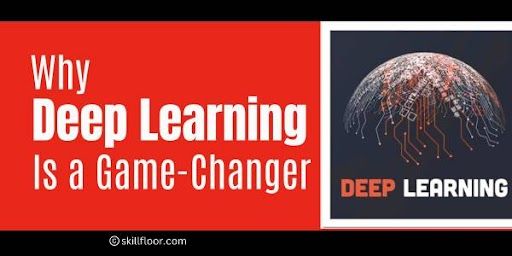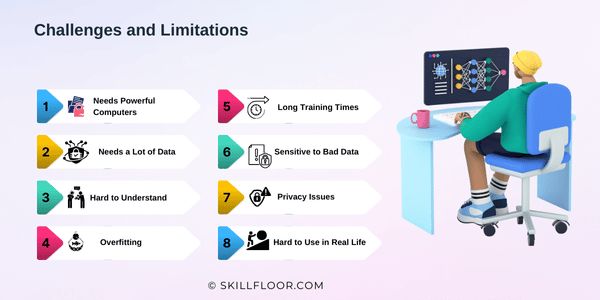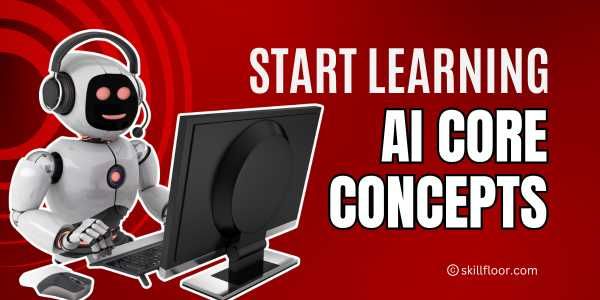Advantages of Deep Learning
The power of deep learning in AI. Explore its advantages, real-world applications, and challenges reshaping industries from healthcare to entertainment.

Deep learning is a powerful AI technique that enables machines to learn from data, leading to breakthroughs in various fields like image recognition, natural language processing, and predictive analytics.
What Makes Deep Learning Unique
In the past ten years, technology has advanced at an incredible speed. From smart assistants like Alexa and Siri to medical tools that help doctors detect diseases, AI is making a huge impact on our lives.
At the heart of these advancements is machine learning. This is a way for computers to learn from data and make decisions without needing step-by-step programming.
Deep learning is a special type of machine learning. It mimics how the human brain works by using “neural networks” to analyze data. Unlike older methods, deep learning is amazing at understanding complicated information like pictures, speech, and videos. It’s a key reason why AI can do so many impressive things today.
Performance Limits with More Data
Even though machine learning is powerful, it has some problems:
-
Needs a Lot of Manual Work: For traditional machine learning to work, data scientists must carefully pick and process the data it uses. This is called feature engineering, and it takes a lot of time.
-
Struggles with Big or Complex Data: Traditional methods often fail when working with videos, speech, or very large datasets.
-
Limited Growth: Adding more data doesn’t always improve the performance of older machine learning methods.
These issues are a problem, especially in today’s world where huge amounts of data are created every second—from social media to smart devices.
This raises a key question: How can deep learning solve these problems, and why is it so powerful?
Why is deep learning transforming industries? What are its key benefits, and how does it tackle the challenges that traditional methods face?
1. Accuracy and Performance
Deep learning is super accurate when solving tough problems. It’s especially good at working with messy data, like pictures, videos, or text.
For example, if you use Google Photos and search for “dog,” it can find every picture of a dog in your gallery—even ones you don’t remember taking. This happens because deep learning can spot tiny details and patterns that even humans might miss.
Another example is speech-to-text apps, like Otter.ai or Google’s voice typing. They can convert spoken words into written text, even if there’s background noise or an accent. In self-driving cars, like those from Tesla, deep learning helps identify roads, people, and other vehicles to drive safely.
2. Automatic Feature Extraction
Traditional machine learning models need experts to manually tell them what features or details to focus on. Deep learning does this automatically—it learns what’s important directly from the data.
Imagine teaching a computer to recognize apples. With traditional methods, you’d have to explain, “Look for something round, red, and shiny.” But with deep learning, you just show it lots of pictures of apples, and it figures out what an apple looks like on its own.
This is why tools like Apple’s Face ID work so well. Instead of manually programming it to recognize facial features, deep learning learns on its own how to identify your face, even in different lighting or angles.
3. Scalability and Big Data Compatibility
Deep learning works great with big amounts of data. Unlike older models that stop improving after a while, deep learning keeps getting better the more data you give it.
For instance, Amazon and Netflix use deep learning to analyze customer data and suggest products or shows you might like. The more you watch or shop, the smarter their suggestions get.
In healthcare, systems like IBM Watson look at millions of patient records to help doctors find the best treatments for diseases. This ability to handle tons of data makes deep learning very powerful in today’s data-driven world.
4. Versatility Across Industries
Deep learning isn’t just for one type of job—it’s useful in almost every industry:
-
Healthcare: Doctors use it to detect diseases from X-rays or MRIs. For example, it helps find early signs of cancer.
-
Finance: Banks use it to catch fraud by spotting unusual transactions.
-
Entertainment: Apps like Netflix and Spotify recommend movies or songs based on what you like.
-
Farming: Farmers use deep learning to check the health of crops using pictures from drones or satellites.
A fun example is how Instagram or Snapchat uses deep learning for filters. It recognizes your face and adds dog ears or sunglasses in real-time.
5. Handling Complex and Unstructured Data
Deep learning is amazing at working with messy or unorganized data, like pictures, sounds, or text.
-
Pictures: Security cameras use deep learning to identify faces or even detect suspicious behavior automatically.
-
Text: Apps like Grammarly understand sentences and help fix grammar mistakes. Chatbots like ChatGPT understand questions and give clear, helpful answers.
-
Audio: Apps like Google Translate can listen to someone speaking in one language and turn it into another language instantly.
It also works in creative areas. For example, Adobe Photoshop’s tools can use deep learning to make changes to pictures, like changing someone’s age or expression, with just one click.
6. End-to-End Learning
Deep learning can handle everything from start to finish without needing extra steps or help from humans.
For example, in speech recognition, older systems needed separate steps to process audio, figure out sounds and then turn them into text. Deep learning skips all that—it listens to the audio and directly gives you the text. This makes apps like Google Translate work faster and smoother.
Another example is drones. Companies like Skydio use deep learning to help drones avoid obstacles and fly by themselves. The drone’s camera sends raw video, and the deep learning model decides how to navigate without needing manual control.
Real-World Applications
To illustrate these advantages further, let’s look at some real-world applications:
-
Autonomous Vehicles: Deep learning enables self-driving cars to identify objects, predict pedestrian behavior, and make real-time decisions. Tesla’s Autopilot system is a prime example.
-
Healthcare Diagnostics: Tools like Google’s DeepMind analyze medical scans to detect diseases like cancer with high precision.
-
Voice Assistants: Alexa, Siri, and Google Assistant rely on deep learning for speech recognition and contextual understanding.
-
Fraud Detection: Financial institutions use deep learning to analyze transactional data and detect anomalies that could indicate fraud.
-
Content Generation: Models like DALL·E and GPT can create images, text, and even videos, opening up possibilities in entertainment and marketing.
Challenges Addressed by Deep Learning
Deep learning solves many challenges faced by traditional machine learning:
-
High Dimensionality: Traditional models struggle with datasets with thousands of variables. Deep learning handles this effortlessly, finding patterns in high-dimensional spaces.
-
Complex Data Structures: Whether it’s nested text data or multi-layered image files, deep learning can parse and analyze complex data structures with ease.
How Deep Learning Compares to Other Methods
When compared to traditional machine learning or statistical methods, deep learning consistently outperforms in areas requiring high accuracy and complex pattern recognition. However, it’s worth noting that traditional models are still preferred for smaller datasets or simpler tasks due to their lower computational requirements.
The Future of Deep Learning
Looking ahead, the potential of deep learning seems limitless. From real-time analytics to generative AI, its applications are expanding at a rapid pace. I believe we’re just scratching the surface of what’s possible. Imagine a world where AI can design medicines, create immersive virtual experiences, or assist in tackling climate change—deep learning will likely be at the heart of these innovations.
Challenges and Limitations
Deep learning is a powerful tool that helps solve many problems, but it also has some challenges. Let’s look at these challenges in a way that’s easy to understand.
1. Needs Powerful Computers
Deep learning requires a lot of computing power. It often uses special hardware like GPUs (Graphics Processing Units) or TPUs (Tensor Processing Units) to handle the heavy work.
-
Why it’s a problem:
-
These computers and devices are very expensive, making it hard for smaller organizations or students to use them.
-
They also use a lot of electricity, which can increase costs and isn’t good for the environment.
-
Example: Training a deep learning model for voice recognition could take weeks on a regular computer, but a GPU can speed it up.

2. Needs a Lot of Data
Deep learning works best when it has a lot of data to learn from. Unlike traditional methods, which can sometimes work with small datasets, deep learning needs huge amounts of data to perform well.
-
Why it’s a problem:
-
Collecting and preparing large datasets takes time and effort.
-
In some cases, like medical research, it’s hard to get enough data because of privacy rules or limited availability.
-
Example: A deep learning model for detecting diseases needs thousands of X-rays to learn. If there aren’t enough images, the model might not work well.
3. Hard to Understand
Deep learning models are like a “black box.” This means it’s difficult to figure out why the model made a certain decision.
-
Why it’s a problem:
-
In critical areas like healthcare or finance, people need to trust the results. If we can’t explain how the model works, it can create problems.
-
Debugging or fixing mistakes becomes harder when you don’t know what’s going on inside the model.
-
Example: If a deep learning model predicts someone won’t repay a loan, the bank might not be able to explain why, which could lead to trust issues.
4. Overfitting
Sometimes, a deep learning model learns too much from the training data and becomes too specific. This is called overfitting.
-
Why it’s a problem:
-
A model that is overfitted will work well on the data it has seen before but fail on new data.
-
This means the model won’t perform well in real-world situations.
-
Example: If a model learns to recognize cats from photos of fluffy, white cats, it might not recognize a black or short-haired cat.
5. Long Training Times
Training deep learning models can take a long time, especially when the data is large or the model is complex.
-
Why it’s a problem:
-
It slows down the process of building and using AI systems.
-
Making updates to the model can also take a long time.
-
Example: A model for translating languages might take weeks to train. If new languages need to be added, retraining the model will require even more time.
6. Sensitive to Bad Data
Deep learning models rely on good-quality data. If the data is incomplete, biased, or has errors, the model won’t work well.
-
Why it’s a problem:
-
Cleaning and fixing data can take a lot of effort.
-
Bad data can lead to bad decisions, which can have serious consequences in some cases.
-
Example: If a facial recognition system is trained mostly on lighter-skinned faces, it might not perform well for people with darker skin tones.
7. Privacy Issues
Since deep learning needs large datasets, it often uses personal information, which can raise privacy concerns.
-
Why it’s a problem:
-
Collecting personal data without permission is unethical and sometimes illegal.
-
Biased or unfair data can lead to decisions that harm certain groups of people.
-
Example: AI used in hiring has been found to favor men over women if the training data included mostly male applicants.
8. Hard to Use in Real Life
Deploying deep learning models into real-world systems can be tricky. They often need to be adjusted to work efficiently on different devices, like mobile phones or cloud systems.
-
Why it’s a problem:
-
Ensuring the model performs well in all situations can take time and effort.
-
If the environment changes (e.g., weather for self-driving cars), the model might struggle.
-
Example: A self-driving car model trained in sunny weather might not work as well in heavy rain.
How Are These Problems Being Solved?
Scientists and engineers are working on solutions:
-
Better Hardware: Newer GPUs and TPUs are faster and more energy-efficient.
-
Smaller Models: Techniques are being developed to shrink models without losing performance.
-
Explainable AI: Efforts are being made to make models more transparent so we can understand their decisions.
-
Synthetic Data: When real data is limited, AI can create fake (but realistic) data for training.
To sum it up, deep learning is transforming the way we interact with technology. From achieving unparalleled accuracy to handling complex and unstructured data, its advantages are reshaping industries and redefining possibilities.
As I see it, deep learning isn’t just a technological advancement; it’s a paradigm shift. It enables us to solve problems that were previously out of reach, pushing the boundaries of innovation.
So the next time you see AI working wonders—whether it’s diagnosing a disease, driving a car, or simply recommending your favorite show—know that deep learning is the powerhouse





























































